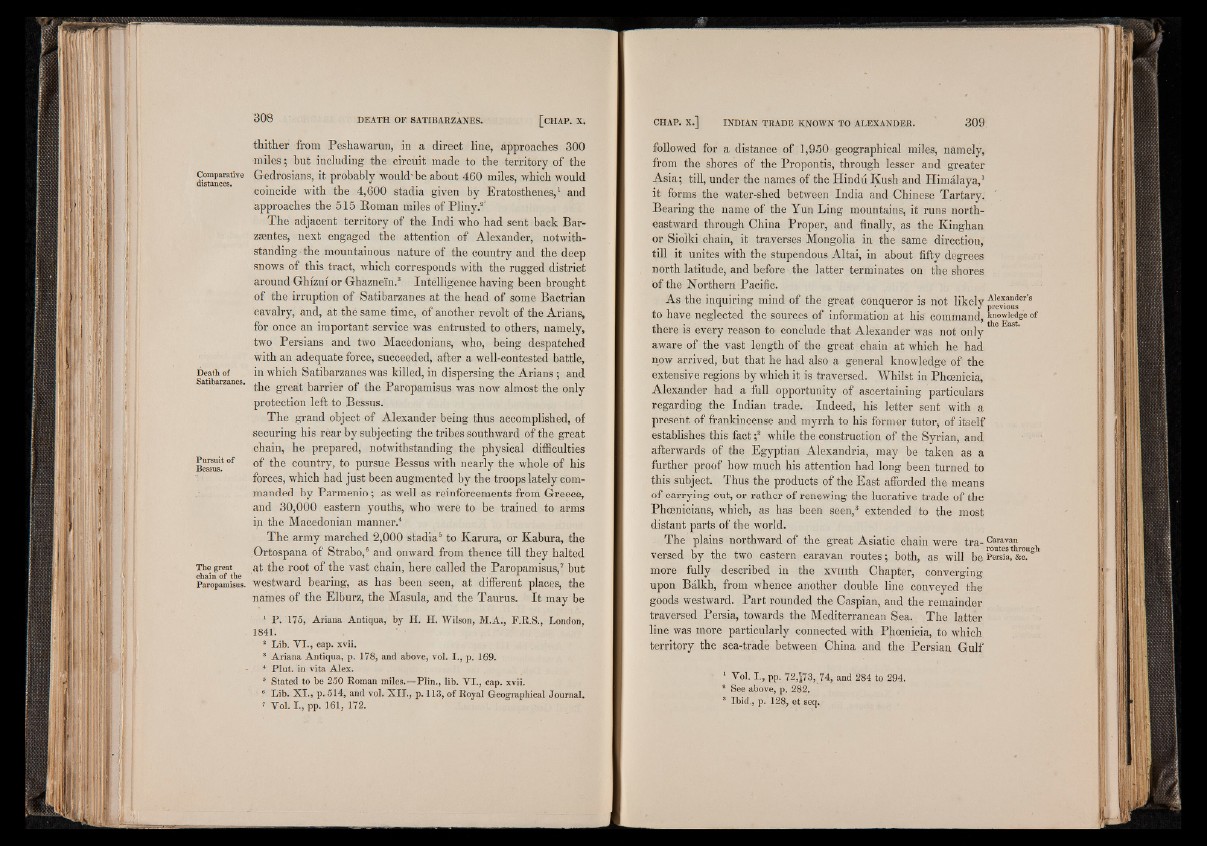
Comparative
distances.
Death of
Satibarzanes.
Pursuit of
Bessus.
The great
chain of the
Paropamisus.
thither from Peshawarun, in a direct line, approaches 300
miles ; but including the circuit made to the territory of the
Gedrosians, it probably would'be about 460 miles, which would
coincide with the 4,600 stadia given by Eratosthenes,1 and
approaches the 515 Roman miles of Pliny.2’
The adjacent territory of the Indi who had sent back Bar-
zaantes, next engaged the attention of Alexander, notwithstanding
the mountainous nature of the country and the deep
snows of this tract, which corresponds with the rugged district
around Ghizni or Ghazne'in.3 Intelligence having been brought
of the irruption of Satibarzanes at the head of some Bactrian
cavalry, and, at the same time, of another revolt of the Arians,
for once an important service was entrusted to others, namely,
two Persians and two Macedonians, who, being despatched
with an adequate force, succeeded, after a well-contested battle,
in which Satibarzanes was killed, in dispersing the Arians ; and
the great barrier of the Paropamisus was now almost the only
protection left to Bessus.
The grand object of Alexander being thus accomplished, of
securing his rear by subjecting the tribes southward of the great
chain, he prepared, notwithstanding the physical difficulties
of the country, to pursue Bessus with nearly the whole of his
forces, which had just been augmented by the troops lately commanded
by Parmenio ; as well as reinforcements from Greece,
and 30,000 eastern youths, who were to be trained to arms
ip the Macedonian manner.4
The army marched 2,000 stadia5 to Karura, or Kabura, the
Ortospana of Strabo,6 and onward from thence till they halted
at the root of the vast chain, here called the Paropamisus,7 but
westward bearing, as has been seen, at different places, the
names of the Elburz, the Masula, and the Taurus. It may be
1 P . 175, Ariana Antiqua, by H. H. Wilson, M.A., F.R.S., London,
1841'.
2 Lib. V I., cap. xvii.
3 Ariana Antiqua, p. 178, and above, vol. I ., p. 169.
4 Plu t. in vita Alex.
5 Stated to be 250 Roman miles.—Plin., lib. V I., cap. xvii.
6 Lib. X I ., p . 514, and vol. X I I ., p. 113, of Royal Geographical Journal.
i Vol. I ., pp. 161, 172.
followed for a distance of 1,950 geographical miles, namely,
from the shores of the Propontis, through lesser and greater
Asia; till, under the names of the Hindu Kush and Himalaya, 1
it forms the water-shed between India and Chinese Tartary.
Bearing the name of the Yun Ling mountains, it runs northeastward
through China Proper, and finally, as the Kinghan
or Siolki chain, it traverses Mongolia in the same direction,
till it unites with the stupendous Altai, in about fiftv degrees
north latitude, and before the latter terminates on the shores
¡of the Northern Pacific.
As the inquiring mind of the great conqueror is not likely ^lejia°jer’s
to have neglected the sources of information at his command, knowledge of
there is every reason to conclude that Alexander was not only 6
aware of the vast length of the great chain at which he had
now arrived, but that he had also a general knowledge of the
extensive regions by which it is traversed. Whilst in Phoenicia,
Alexander had a fiill opportunity of ascertaining particulars
regarding the Indian trade. Indeed, his letter sent with a
present of frankincense and myrrh to his former tutor, of itself
establishes this fact ;2 while the construction of the Syrian, and
afterwards of the Egyptian Alexandria, may be taken as a
further proof how much his attention had long been turned to
this subject. Thus the products of the East afforded the means
of carrying out, or rather of renewing the lucrative trade of the
Phoenicians, which, as has been seen,3 extended to the most
distant parts of the world.
The plains northward of the great Asiatic chain were tra-Caravan i t ,i , 1 ■ . , routes through versed by the two eastern caravan routes; both, as will be Persia,&c.
more fully described in the xvmth Chapter, converging
upon Balkh, from whence another double line conveyed the
goods westward. Part rounded the Caspian, and the remainder
traversed Persia, towards the Mediterranean Sea. The latter
line was more particularly connected with Phoenicia, to which
territory the sea-trade between China and the Persian Gulf
1 Vol. I ., pp. 72,J73, 74, and 284 to 294.
2 See above, p. 282.
3 Ibid,, p. 128, et seq.